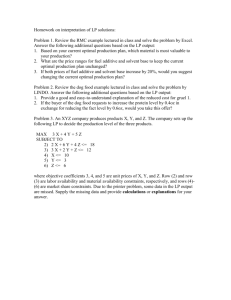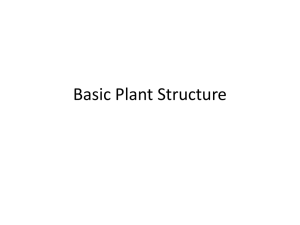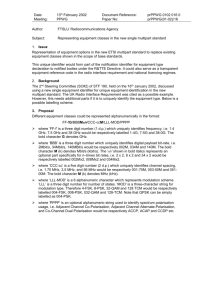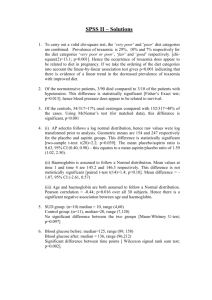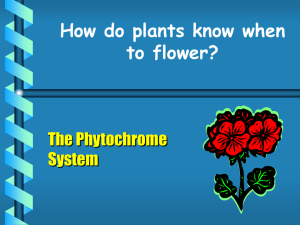respectively experiment
advertisement
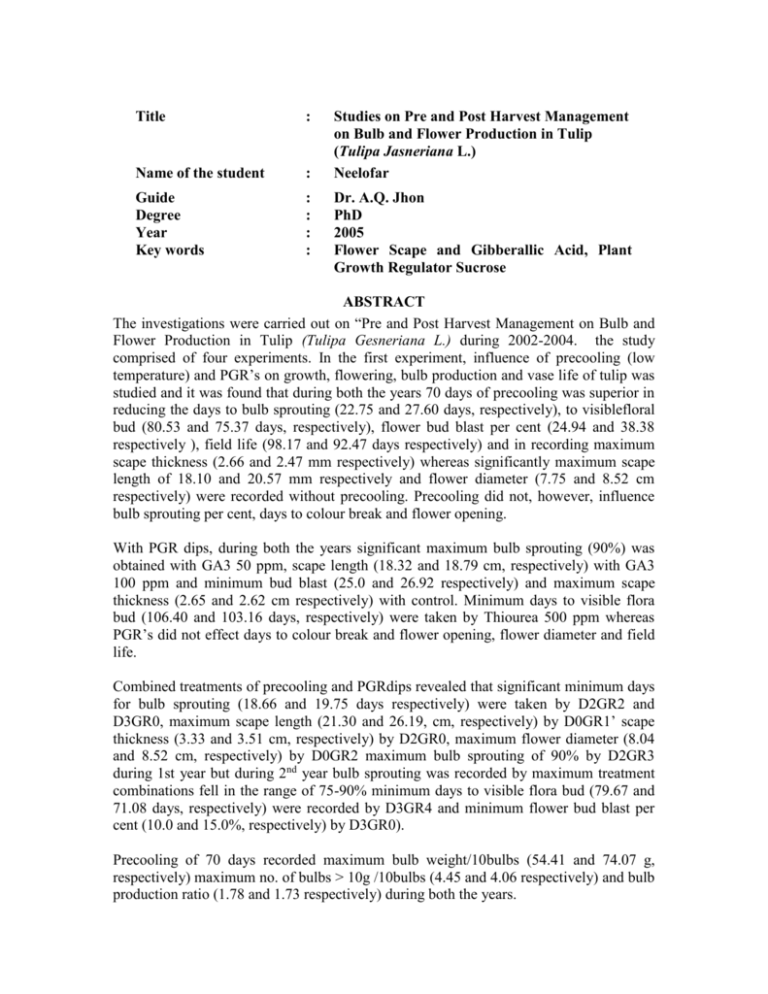
Title : Name of the student : Guide Degree Year Key words : : : : Studies on Pre and Post Harvest Management on Bulb and Flower Production in Tulip (Tulipa Jasneriana L.) Neelofar Dr. A.Q. Jhon PhD 2005 Flower Scape and Gibberallic Acid, Plant Growth Regulator Sucrose ABSTRACT The investigations were carried out on “Pre and Post Harvest Management on Bulb and Flower Production in Tulip (Tulipa Gesneriana L.) during 2002-2004. the study comprised of four experiments. In the first experiment, influence of precooling (low temperature) and PGR’s on growth, flowering, bulb production and vase life of tulip was studied and it was found that during both the years 70 days of precooling was superior in reducing the days to bulb sprouting (22.75 and 27.60 days, respectively), to visiblefloral bud (80.53 and 75.37 days, respectively), flower bud blast per cent (24.94 and 38.38 respectively ), field life (98.17 and 92.47 days respectively) and in recording maximum scape thickness (2.66 and 2.47 mm respectively) whereas significantly maximum scape length of 18.10 and 20.57 mm respectively and flower diameter (7.75 and 8.52 cm respectively) were recorded without precooling. Precooling did not, however, influence bulb sprouting per cent, days to colour break and flower opening. With PGR dips, during both the years significant maximum bulb sprouting (90%) was obtained with GA3 50 ppm, scape length (18.32 and 18.79 cm, respectively) with GA3 100 ppm and minimum bud blast (25.0 and 26.92 respectively) and maximum scape thickness (2.65 and 2.62 cm respectively) with control. Minimum days to visible flora bud (106.40 and 103.16 days, respectively) were taken by Thiourea 500 ppm whereas PGR’s did not effect days to colour break and flower opening, flower diameter and field life. Combined treatments of precooling and PGRdips revealed that significant minimum days for bulb sprouting (18.66 and 19.75 days respectively) were taken by D2GR2 and D3GR0, maximum scape length (21.30 and 26.19, cm, respectively) by D0GR1’ scape thickness (3.33 and 3.51 cm, respectively) by D2GR0, maximum flower diameter (8.04 and 8.52 cm, respectively) by D0GR2 maximum bulb sprouting of 90% by D2GR3 during 1st year but during 2nd year bulb sprouting was recorded by maximum treatment combinations fell in the range of 75-90% minimum days to visible flora bud (79.67 and 71.08 days, respectively) were recorded by D3GR4 and minimum flower bud blast per cent (10.0 and 15.0%, respectively) by D3GR0). Precooling of 70 days recorded maximum bulb weight/10bulbs (54.41 and 74.07 g, respectively) maximum no. of bulbs > 10g /10bulbs (4.45 and 4.06 respectively) and bulb production ratio (1.78 and 1.73 respectively) during both the years. With PGR dips maximum bulb weight/10bulb and no. of bulbs > 10g/10bulbs was recorded with control. However, control was closed to GA3 100 ppm recording maximum no. of bulbs > 10g/10 bulbs. The later treatment also recorded highest bulb production ratio (1.96 and 1.61 respectively) by D0GR1. During both the years 70 days of precooling was superior in recording minimum days (5.37 and 4.77, respectively) for flower opening maximum vase life (8.32 and 8.17 days respectively) flower opening (80.59 and 82.29%, respectively) whereas, maximum flower diameter (8.67 and 8.44 cm, respectively) was recorded without precooling of bulbs. Precooling had a non-significant influence on all other parameters studied. During both the years minimum days to flower opening (4.55 and 4.30 days, respectively) were recorded by GA3 50 ppm and maximum vase life of 6.44 and 7.16 days, respectively by Thiourea 500 ppm which was close to GA3 100 ppm. The effect of PGR dips on other parameters studied was non-significant. In the second experiment pulsing treatment with flora preservative and sucrose had a non-significant effect on all parameters studied. However, better results were obtained with Su 4% + CaCl2 500 ppm for flower opening and vase life, Su 4% + Al2 (So4H 100 ppm for flower diameter, Su 4% + SA 100 ppm, Su 4% + CaCl2 1000 ppm for flower opening during both the years. Fresh weight increased till 8th day thereafter it decreased. In the third experiment pulsing treatment with growth regulators revealed that minimum days to flower opening (6.66 and 6.99 days, respectively) drying both the years were taken when perspective solution of Su 2% + 8HQ 200 ppm + CA 300 ppm (C0) was supplemented with SA 10 mg/1 and scapes were pulsed for 4h. flower diameter was maximum (6.90 and 6.87 cm, respectively) with SA 10g/l for 8h. during both the years. Maximum vase life of 6.88 and 6.77 days, respectively was recorded by SA 20mg/l for 4h where flower opening was maximum (90.0%) with SA 10g/l for 48h during first year and SA 20g/l for 4 and 8h during 2nd year. Minimum water loss (8.78g/Scape) was recorded by GA3 100 ppm for 8h. there was, however, no effect on other parameters studied. In the 41 hectare experiment the results on dry and wet storage of cut tulips revealed that minimum days to flower opening were taken by wet storage of 6 and 8 days. During both the years largest flowers (6.90, 6.71 and 6.36, 6.13 cm respectively) were obtained with dry and wet storage of 0 and 2 days. Vase life of flowers decreased with the increase in storage period and zero days of wet storage recorded maximum vase life (7.55 and 7.99 days respectively) during both the years which was at par with 0 days dry storage and 4 and 6 days wet storage. Flower opening was best with 0, 2 and 4 days of dry and wet storage whereas flowers stored dry for 8 days did not open at all. Others parameters studied were not influenced significantly either by dry or wet storage. -o-
